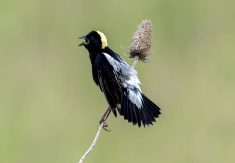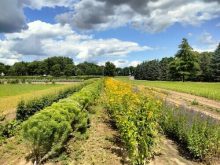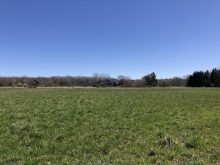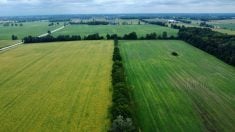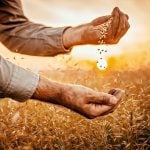Canada has committed to protecting 30 per cent of the country’s natural land and seascapes by 2030.
In southern Ontario, that could mean doubling the amount of Carolinian wetland, forest, and grasslands – habitats comprising a mere 15 per cent of the region’s landscapes.
Why it matters: The strategy aims to increase the diversity of native plant species in Ontario’s Carolinian landscapes.
There’s a problem, though. Even if enough landowners signed on to achieve such environmental goals tomorrow, there isn’t enough seed from native Carolinian species to go around.
Read Also

Melancthon faces a new quarry fight over water, environment and farmland risks
A proposed Strada blast quarry in Melancthon, Ont., sparks regional debate over water protection, farmland sustainability, and Ontario’s aggregate policy.
This reality is the impetus behind the 2024 Southern Ontario Seed Strategy, developed by Carolinian Canada in partnership with the Canadian Wildlife Federation, The Greenbelt Foundation, Environment and Climate Change Canada, Ontario Native Plant Growers Association, and several other organizations and native seed companies.
What is it?
As defined in the Seed Strategy, native plants are flora considered indigenous to an area, which evolved in the presence of native soils and climate in tandem with other native plant species, animals, fungi and bacteria. In North America, native plants are commonly defined as the species that existed on the land prior to European colonization.
Carolinian Canada’s Southern Ontario Native Seed Strategy is a framework for addressing the current lack of diversity and quantity of native seed, as well as related barriers to achieving Canada’s environmental restoration goals in Ontario’s Carolinian zone – one of the most ecologically diverse biomes in Canada, as well as one of the smallest and most threatened.
The strategy supports actions to scale up the availability of genetically appropriate native seed and “connect participants in the native plant supply chain, from growing to planting,” to those looking to plant native species. Connections with Indigenous communities and Indigenous knowledge regarding native seed collection and production comprise part of the strategy. Overall, it identified five separate goals:
1. Expand ethical and safe space within the native plant sector.
2. Increase supply and support demand for reliably available genetically appropriate native seed.
3. Develop tools that allow co-ordinated, timely, informed action for seed conservation and stewardship.
4. Develop strategies for widespread use and adoption of native plants within consumer, industry, and policy sectors.
5. Employ Western and Indigenous knowledge to inform and support a native seed supply chain for restoration.
The challenge
Jennifer Nantais, healthy habitat manager with Carolinian Canada, says some inspiration for the Ontario Strategy came from similar approaches developed in parts of the United States, and the recognition that Ontario’s native seed production would, at present, be woefully inadequate should demand significantly increase.
“There’s funding for corn, soybeans and wheat, but not native plants,” says Nantais, referring to research, development, and other investments in crop production generally. Native seed diversity also needs to be expanded along with general supplies and suppliers. As of this writing, she estimates there are just a dozen members of the Ontario Native Plant Growers Association – although many others participate in native seed production and gathering at lower levels.
“People don’t know we don’t have the plants…Folks often can’t find the amount of seed they need or when they need it. That’s because they don’t really connect to the supply and demand side.”
Part of the challenge is rooted in native seed agronomy and economics. Native species don’t grow in large monocultures like the field crops typical of southern Ontario. Seed gathering can be very labour-intensive as a consequence. Knowing what to look for and how to harvest is a skill – and part of the reason Carolinian Canada stresses the importance of Indigenous knowledge within the Strategy. Economic volatility and risk management for native seed growers is also a challenge. While Nantais says contracts for seed are ideally in place to mitigate that risk to growers, it can still be a fraught business.
Rob Messervey, native plant producer and vice-chair of the Ontario Native Plant Growers’ Association, stressed the importance of regular supply of, and demand for, native seeds to growers. During the Jan. 14, 2025 Seed Strategy launch, Messervey says investments are required to ensure adequate seed supplies for nurseries, the latter being able to scale up production. Creating “seed orchards” would help ensure such supplies, as would establishing robust pooling and distribution systems.
“We have a wide diversity of customers, and that diversity of interest and demand is growing,” he says.
Like Nantais, though, Messervey identifies market uncertainty – unpredictable demand for volume and species type, for example – as an ongoing challenge. This is more challenging given some species take many years to produce seed. Seed collection also requires significant expertise, necessitates access to land, good logistical timing, and other factors, while harvesting occurs annually with or without contracts for the collected seed.
“We need to match demand with our seed collection activities. And as we know, level of demand, if it changes, it also changes the impacts on staff and structural capacity of growers and the need for recruitment, training and supplies. But I think the strategy is really going to help us move forward on a couple of those challenges,” says Messervey.
He adds native seed growers need better planning and multi-year forecasting – particularly for larger end buyers like conservation authorities and municipalities – and earlier proposals for growers, allowing for more precise production decisions. Information on trends or changes in what species are being sought after would also be of value at the propagation level.
For Nantais, solving these and other aforementioned challenges would economically benefit Ontario while providing a means of safeguarding our natural resources.
“Only about 15 per cent of land in southern Ontario is natural habitat,” she says. “The estimates say we need to double this to ensure healthy water and landscapes going forward.”







